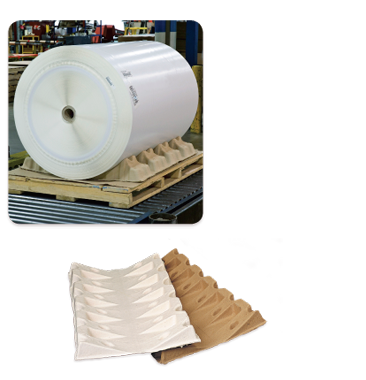Innovative Shipping Solutions: 3,000-4,000 lb. Pressure-Sensitive Rolls
When it comes to shipping materials, whether it’s across town or across the country, what matters most is making sure your product arrives undamaged.
And that’s precisely the challenge that the Coated Products Operations of Green Bay Packaging faced when shipping 3,000 to 4,000 lb. rolls of its pressure-sensitive label material via rail from Green Bay, Wis.
The company found that the jolting starts and side-to-side rocking motion of the boxcars caused wood wedges to loosen from the pallets, which allowed the rolls to move against the metal banding used to secure the product to wood pallets. The rolls measure 52 to 60 inches in length and 32 to 50 inches in diameter and sustained heavy damage from friction with the metal banding. But this movement also put additional pressure on a customized honeycombed wedge product, causing it to fail and ultimately allow the rolls to move more.
There were also instances where the loosened wedges broke free of the banding altogether, even though each pallet was stretch wrapped. In addition to leaving the rolls totally unprotected, this greatly increased the likelihood of a load shift that could have resulted in a derailment. It’s one thing to have a semi tip, but quite another when it’s a rail car that’s tethered to other boxcars.
“We knew we had to do something quickly to get the damage under control because it was becoming very costly,” said Todd Keckhaver, production manager with Green Bay Packaging. “There were times when the entire load had shifted and sustained some sort of damage.
Rollguard’s Solution For Green Bay Packaging
The solution, provided by Rollguard®, was literally in-house.
“I saw some incoming material from one of our suppliers packaged in a way I thought could work for our large rolls and just took the name off it,” Keckhaver said. “It was a fiber roll cradle from Rollguard.”
As luck would have it, Rollguard is headquartered about 30 minutes south of Green Bay Packaging. So getting samples to them in short order was no problem.
“We looked at the pressure sensitive label material, how it was being shipped and the resulting problems Green Bay was experiencing,” said Gary Lawell, account manager with Rollguard. “We determined the best solution was our full roll RF-40-FRS cradle product. It’s a standard roll handling inventory item for us and specifically designed to accommodate rolls up to 40 inches in diameter. Because we have one of the broadest selections of stock sizes of roll cradles, we were able to provide a cost-effective solution immediately.”
“Rollguard brought in product samples, which we took out to the floor and used right away to ship a couple of rolls,” Keckhaver said. “Everything shipped just fine.”
The full-roll-support cradle is made from recycled corrugated molded pulp. It measures 37 inches wide by 47 inches in length. The density of the molded pulp also has less dusting compared to similar pallet cradles made from honeycomb material. And because the full-roll cradles use more surface area to support the rolled product, they eliminate marking damage caused when products are supported by their edges alone.
“The type of cradle we specified for Green Bay is engineered to hold large master rolls in place,” Lawell, said. “It has a higher-than-average wall height and that 5-1/2 inches provides a deep well that holds the roll securely in place. It provides a better overall fit to the contour radius of the roll compared to a honeycomb product.”
For Green Bay Packaging, all that’s necessary is to set the Rollguard cradle on the pallet and place the roll in the cradle. Next, two bands are placed across the roll lengthwise to secure it and the cradle to the pallet. Because plastic bands are used, no band padding is required. Stretch wrap is then applied to the entire pallet. This final step protects the outer layers of the label material and further unitizes the load.
The previous method of palletizing the loads was more labor intensive because the wood wedges were nailed to the pallets. This also posed problems after shipment because the pallets had to be disassembled. In some cases this damaged the pallets, which resulted in disposal and repair issues. There was also the added hurdle of making sure all the wood that was used was kiln dried to ensure it was bug-free.
Green Bay Packaging After Using Roll Cradles
“The way it works now is perfect,” Keckhaver said. “We just take the cradle off and reuse the pallet.”
The sturdiness of the cradles has delivered an unexpected bonus to Green Bay Packaging.
“We thought the cradles were a one-use item. That we’d send them one way and that would be it,” Keckhaver said. “But we often ship material to our other facilities for converting. When the product is returned here to Green Bay, the other plants actually send the cradles back. So we’ve been able to reuse them. The structural integrity of the cradles holds up very well. And that’s enabled us to get additional turns out of them, which has been an added benefit.”
